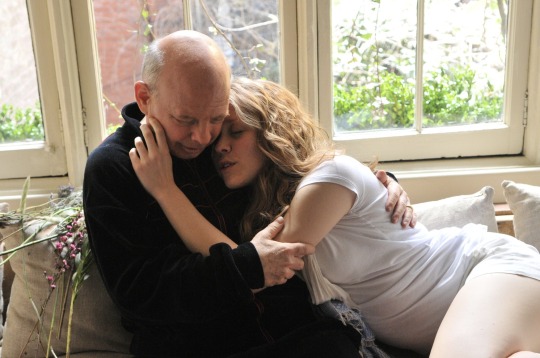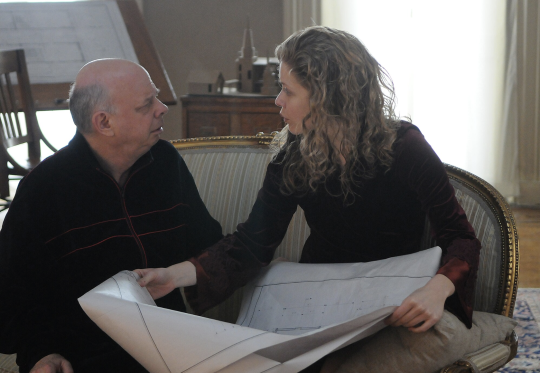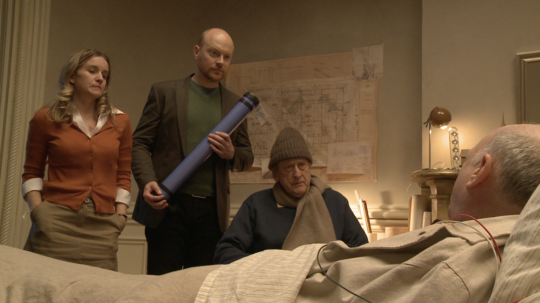Jonathan Demme’s ‘A Master Builder’ and the Elusive Magic of Bringing Stage to Screen
By Yasmina Tawil

Criterion’s three-film box-set of the works of Wallace Shawn and Andre Gregory—My Dinner With Andre, Uncle Vanya, and A Master Builder—features several supplements, including an interview between the theater artists and writer Fran Lebowitz. She makes a frank confession: “I don’t like watching theater.” Gregory, a man who’s spent his entire life in the theater, says he feels the same way.
Lebowitz explains that she loves to be drawn into a good film or novel, but, with the exception of Shawn’s work, she’s never experienced the same with theater. She’s not alone. While theater may not exactly be a dying art form, it was long ago upstaged by cinema and television as our de-facto entertainment, and our appreciation for it has dwindled in kind. Theater requires us to suspend disbelief that we’re watching mere make believe, more forcefully than film, which benefits from a metaphysical distance from the viewer. Why sit through 2-3 hours of physical artifice just to see actors move through the spectrum of human emotion when there are so many easier and supposedly better options?
Those lucky enough to have witnessed really good theater know this a philistine’s line of thinking, but even so, its cultural relevance is tightly bound to its usurper, cinema: film adaptations of plays are usually better known than famous productions. (Consider the populist understanding of A Streetcar Named Desire without Marlon Brando—it doesn’t exist.) But adaptations are in essence, films, not theater. Transmitting the visceral pleasures of actual theater is nigh-impossible. If you’ve ever made the mistake of watching a recorded stage performance, you know you’re missing an essential thing privy to members of the audience. No matter the quality of the performance or camerawork, filming a play cheapens the experience. Theatricality is transmogrified into an over-exaggerated mess onscreen. The chemistry unique to each performer and audience, which gives birth to an atmospheric energy that changes with every performance, is lost.
A Master Builder director Jonathan Demme tries to describe a similar sentiment in another Criterion supplement, an interview between himself, Shawn, Gregory, and critic David Edelstein. Having seen the duo’s final production of A Master Builder —which Demme calls “literally spell-binding” and “very emotionally intense”— the director chronicles in the interview his experience watching Gregory watch the play. Having finished his part as Brovik, Gregory joined the audience, but, according to Demme, appeared to subconsciously direct the performers as if through an “energy field.”

“I remember seeing his face responding to everything that was going on there and feeling the connection,” he says. Edelstein follows up with questions, as what he’s hearing sounds too “woo woo”: Were the performers looking at Gregory? Was he in their peripheral vision? … What, exactly? It’s not Demme’s fault he can’t eloquently explain the phenomenon, because words rarely do the experience of live theatre justice. It’s an inexplicable sensation that can only be experienced to be understood.
Filmmakers sometimes struggle adapting plays for the screen. Those who succeed understand the key differences between the artforms. They preserve the essence of story and drama, the play’s unique blueprint. They subtly reframe the story to be told more visually. And they honor the reality that plays are usually verbose in nature. Results have varied in quality from baffling (August: Osage County) to transcendent (Amadeus). But the outcome is usually more accomplished in the literary appreciation of theatre—say, a modern or unique interpretation of a classic text, like Orson Welles’ Macbeth—than the emulation of that woo-woo theatre magic.
And then there’s Demme. The director took on Shawn and Gregory’s third film collaboration. A Master Builder is dedicated to Louis Malle, who brought to life the actors’ long-form conversation My Dinner With Andre and their modern interpretation of Anton Chekhov’s Uncle Vanya. Demme was a perfect replacement for Malle, as they share a visual intimacy in their work. Demme also benefits from a swirling chain in his aesthetic DNA: an unparalleled gift in recording live performance that sometimes makes you feel like you’re really there, really present, inhaling the performers’ energy.

In his concert films, including the masterpiece Stop Making Sense, Demme captures both spectacle and the musicians’ shamanistic force. In Swimming in Cambodia, a kind of filmed play, for lack of a better term, it feels as if you really are watching Spalding Gray’s affecting one-man show. Demme relies on close-ups to get us as close as possible to the performer, but maintains a respectful distance. Instead of trying to direct the performers to be more naturalistic for the screen, he blends himself into their forcefield. Perhaps this is why Demme is able to transform Shawn and Gregory’s take on Henrik Ibsen’s play into something simultaneously cinematic and theatrical. The humanistic, democratic POV that Demme often brings to his work nearly elides his personal perspective, thus allowing the viewer to virtually breathe in the full depth of the performer’s space and energy.
Shawn plays Master Builder Solness, a narcissistic aging architect who won’t allow his associates Brovik (Gregory) and his younger son Ragnar (Jeff Biehl) to build anything on their own. Tensions in Solness’ personal and professional life are a direct consequence of his tight reign over his company. Suddenly a mysterious nymph-like woman named Hilde (Lisa Joyce) visits the Solness estates, and their past history is one of many contradictions the play teasingly weaves into its narrative. Through the course of their labyrinthine conversation, the viewer understands how Solness views his selfish actions, the traumatizing effect they’ve had on his loved ones, and his deceptively innocent explanation, simply imagining his success into existence.
Ibsen’s original The Master Builder is a difficult play to mount and even more trying to comprehend, full of delightful contradictions that produce different interpretations. One understanding—supported by Shawn and Gregory’s modern adaptation—is that Hilde is an imaginary figure in Solness’ death fantasy, a chance for him to reckon with his many mistakes. Shawn and Gregory crystallize Ibsen’s ambiguous magical realism into something more obvious, turning the typically physically robust Solness, who self-deprecates about his inner “trolls,” into someone who actually resembles one. (No offense to Mr. Shawn). It’s clearly intentional. He’s on his deathbed but then suddenly dashes into a spry man upon Hilde’s introduction. Their conversations are all a dream, despite seeming real. Occasionally the film interrupts their garrulous chemistry to show a more liminal headspace that very well could be reality: we hear beeping monitors and frantic nurses trying to save the comatose Solness, but all we see are Demme’s signature mobile establishing shots of trees and the architect’s many buildings.

In A Master Builder, Demme gives the actors sufficient room to block their minimal but lustful action. The beautiful interior architecture provides an elegant and visually interesting complement to what is essentially a chamber drama, that most notoriously difficult kind of story to film. Demme toned down the actors’ acting so that it was suitable for the screen, as film tends to capture every minute facial twitch and shift in body language. But the actors retain a good portion of their theatricality, as it’s the play they’d been rehearsing and performing for many years. This is a rare feat in film adaptation: the preservation of theatre’s intensity and magic that piques curiosity in Ibsen’s strange little play.
The Master Builder thrives or dies on the dynamic between the actors who play Solness and Hilde; their immediate palpable chemistry is imperative to intrigue the viewer. So much of the play focuses on these two strangers oversharing personal details, a conversation that delves deeper and deeper into personal, vulnerable territory. It only makes sense for the viewer to know why these two people seemed “destined” to meet again, why we want to hear them speak at length, and with such intensity. The use of close-ups to capture Hilde’s wild-eyed fascination for her master builder, her hunger evident through body language, all seems outlandish for a long while until she reveals details of their shared history that Solness conveniently forgot. It sounds tedious but the pace is dramatic given the ugliness of their past. Until then, the viewer remains bewildered why a young, ambitious and confident woman would ever be so openly smitten by a troll.
Shawn and Gregory downplay an integral component of the story, however, to suit their “death fantasy” interpretation, for better or worse: in Ibsen’s original, it is pretty obvious Solness physically handled the 12-year-old Hilde in some inappropriate manner (according to her, he, all but a stranger to this child, kissed her on the mouth, called her a princess, and promised to build her a castle in ten years). It’s a conversation that is more grounded in the original and treated more lightly and ambiguously in this version. A practical, psychologically grounded interpretation of the original might conclude Hilde’s pursuit of her abuser is a trauma bond she never recovered from, with the “princess in the castle” fantasy carrying her through adolescence into young adulthood and here we are, ten years to the day, Hilde having found her master builder at last, so he can deliver on his promise.
But the film suggests a different understanding: here, Hilde is not so much a real character with baggage guiding her actions as she is a fantastical figure in Solness’ final reckoning with his id. While Ibsen appears to have written Hilde as something of a wild child (and there is symbolic value pointedly repeated in dialogue about her stay in the Solness residence’s empty “children’s rooms,” her presence also representing Solness’ guilt about his deceased children), Shawn and Gregory’s maximalist interpretation has Hilde literally wearing a childlike outfit. These outlandish aesthetic choices, while more acceptable in theatre, veer into ludicrousness in the subtler frame of the camera, but Demme’s setup elegantly frames it for magical realism—a form that some people have intuited was Ibsen’s real objective with The Master Builder.
One reason why this play remains a lesser produced work by the Norwegian playwright is its baffling complexity. Its many contradictions don’t offer any satisfying interpretation. One way to cut through the bullshit for a theater artist—especially one responsible for bringing it to the masses via film—is to hint heavily at their interpretation without directly spelling it out. That approach works best for two-dimensional, captured film. Otherwise the viewer may find A Master Builder, no matter how refined and well-filmed, an obfuscated maze to walk through. There’s just enough realism to make us question whether or not we are watching reality or a death fantasy. In either case, it’s a fascinating exploration of a narcissistic mind, and a gem of a play granted wider access through the medium of film.


